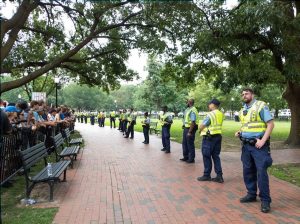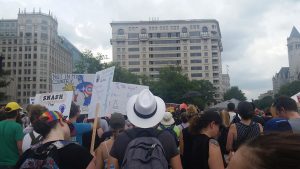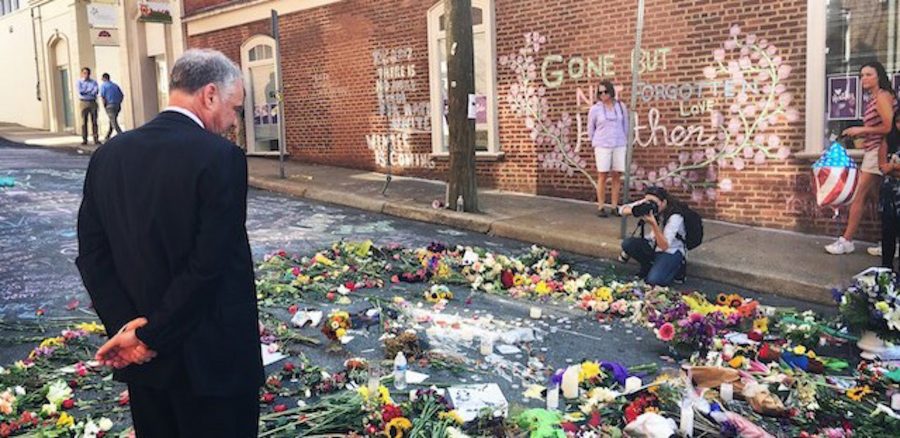I nervously checked Twitter on the day the Unite the Right rally in Washington D.C. took place, on the one year anniversary of the deadly white supremacist attacks in Charlottesville. I had watched interviews with Heather Heyer’s mother who, when asked what justice for her daughter would look like to her, said “I don’t know that you could ever call it justice for Heather. Nothing is ever going to bring Heather back.” [*1] I worried that, as white supremacy became more explicit in the actions and policies of the White House — from racist tweets by the president to mass incarcerations and deportations of non-white people — an attack like the one on August 12th last year was almost bound to happen. But it didn’t. The Unite the Right rally in D.C. was practically a non-story. Anti-racist protesters vastly outnumbered Jason Kessler’s two dozen white nationalists. Some were even afraid to show their faces for TV crews. The question is: Why?
To begin to answer this, I will go back to the position that I took regarding this issue last year. About a month after the events of Charlottesville took place, I published an article in which I explored what academia’s role in combating the alt-right movement should be. While other students and liberals have argued for debating the alt-right and showing them the error of their ways through reason, I argued for something else. As much as I would like to believe that it is actually possible to sway far-right-wing/fascist opinions through debate, I am still not only deeply skeptical of this notion, but I also find it to be a very dangerous position to take. By inviting these speakers to debates, their viewpoints are legitimized and their bigotry is solidified as just another political ideology that is to be debated. If an ideology can be debated, then it could potentially win that debate, and I am not willing to accept even the possibility of white supremacy being a winning argument.
Using academic language, dressing “respectably” and occupying the authority-giving spaces of podiums, far-right speakers could make themselves look reasonable. In fact, this summer I met a Bard student who attended the event at the Hannah Arendt center with AfD ideologue Marc Jongen who said that even though she didn’t agree with him, she didn’t feel that he said anything “too extreme” or “unreasonable”. I finally got around to listening to Jongen’s speech and I now understand why that was her response. He started talking about how the AfD began as a party that was skeptical of the euro as a currency and slowly went from that to the AfD’s skepticism and opposition to the new wave of immigration. Through the speech he continuously made references to different philosophers’ thinking, including that of the controversial philosopher Carl Schmitt, who is associated with the Third Reich. He kept clarifying that, of course, his party doesn’t believe in a Germany that is just ethnically German, but he stated [*2]:
A sufficiently strong consciousness of ‘we’ for a functioning democracy can only be established among a people who share the same values and thus will engage in a common project for the future. And for sharing the same values, to put it very cautiously, it’s very helpful to be rooted in a common ground, to be united by a common past or history.
By using academic language, Jongen proposes that democracy works best when the majority of the people in the country belong to the same ethnic and cultural group. Jongen calmly and “cautiously” suggests that maybe Germany would function best if it were mostly ethnically German, bringing an outrageous opinion into acceptability via polite language.

Taking all of this into account, I concluded in my previous article that academia should reject these imposed discourses and instead advocate for more tolerance and inclusion rather than giving racists and fascists podiums.
I find that Karl Popper’s concept of the “paradox of tolerance” is helpful in understanding why certain views simply cannot be debated or tolerated in a pluralistic society. [*3]
Unlimited tolerance must lead to the disappearance of tolerance. If we extend unlimited tolerance even to those who are intolerant, if we are not prepared to defend a tolerant society against the onslaught of the intolerant, then the tolerant will be destroyed, and tolerance with them.
In other words, intolerance that can take the form of racism, fascism and other -isms cannot exist side by side with tolerance and inclusion because they are inherently opposite principles. Racism and fascism are by definition exclusionary of certain groups of people, such as racial and religious minorities. This means that these ideologies cannot simply be tolerated as just another set of ideas because, if any ideology could “win the discourse” in a democratic society, then so can fascism. And if fascism wins the discourse, there will be no more tolerant and pluralistic discourse because there would systemic exclusion and repression.
A year later, I still stand by what I wrote. I still think that it’s of utmost importance to not give people like Richard Spencer the spaces of university lecture halls to spread and give legitimacy to his white supremacist ideology. If someone like him were to be invited to speak at our university, I would certainly participate in and help organize the demonstration against him. However, as important as university spaces can be in shaping our political landscape, they are not the only entities that determine what enters the realm of acceptability.
Obviously, because of the size of their platforms, what politicians who are running for office or ones that are already in power choose to say greatly influences public discourse. When a presidential candidate starts his campaign by saying that “Mexicans are rapists” and then wins that presidential race, the realm of acceptable discourse has already been shifted. Since the presidential candidate who began his campaign with overt racism won, these views are no longer underrepresented, let alone “marginalized”. Even if racist and white supremacist views were underrepresented, I would not be sympathetic to really giving them a platform. But my values about this aside, these views are currently in the mainstream. Thus, it’s not a matter of elevating repressed viewpoints that liberal students or professors should rally around. It’s a matter of dangerous views already having institutional power in the form of the US presidency and other significant branches of government. To me, wanting to give far-right speakers university spaces makes one to a certain degree complicit in bringing these ideologies into the realm of the acceptable.

Still, politicians and university professors do not hold all of the power and are not the only ones who can challenge the new rise of white supremacy. The street is also a political space. The street provides a unique space where the Left and those with anti-racist values can undermine the far-right in a time when it has very little institutional power. Anti-racist groups could still mobilize enough private citizens to counter the people ready to showcase explicit and violent white supremacy — people who are by no means the majority. If the Left is able to shut these rallies down, then a precedent can be set in other political spaces such as academia and electoral races about what is unacceptable discourse. Judging from this year’s Unite the Right turnout in D.C. it seems that academia and politicians have a lot to learn from the strategies that anti-racist citizens, activists and journalists used over the past year.
Last year, hundreds of white men yelled Nazi salutes such as “Blood and Soil” in public without hiding under masks or hoods because they felt that their ideology had entered the realm of not only acceptability, but also power. President Trump failed to denounce the violence at Charlottesville by famously saying that there was “violence on many sides” and “very fine people on both sides” while having made a slew of political decisions that could be viewed as parallel to white supremacy at the very least. Trump may not have explicitly advocated for an ethno state, but he implemented the Muslim ban and still pledges to build a wall at the US-Mexico border — both are policies designed to keep brown immigrants out of white America. Encouraged by these kinds of actions, Richard Spencer, Jason Kessler and their followers simply expressed the next logical step: overt white supremacy.
Of course, the fact that Unite the Right 2 failed does not mean that white supremacy has been defeated, but it does mean that a certain kind of white supremacy has ceased to be acceptable. Even though they lacked institutional power, private citizens’ and journalists’ actions have been instrumental in the containment of the white supremacist movement. To understand how things went down in D.C. better, I talked to my friend Annina Chaesson, who attended the counter demonstration on the 12th of August who wrote also wrote an article on the topic. From talking to her and following what has been happening during the past year, I have been able to identify the three main tactics that kept the alt-right crowd so small at D.C. These are: 1) revealing the identities of white nationalists by journalists, 2) not providing special metro transportation for the participants, and 3) mass mobilization of counter protesters.
Unless we happen to personally know white supremacists or we have access to a media platform, most of us cannot really participate in the first strategy for containing this movement. Thankfully, some journalists are doing the hard work of figuring out who these white supremacists are, which organizations they are a part of, and then, of course, presenting them to the public. Reporter A.C. Thompson did this exact work over the past year and then documented it through the help of FRONTLINE and ProPublica in a documentary called Documenting Hate: Charlottesville. In the documentary, Thompson shows how he tracked down specific protesters who were present in Charlottesville last year and later exposed them as members of white supremacist groups by publishing articles about them. Pretty much all of the white supremacists that he exposed ended up losing their jobs because their employers did not want to give employment to people who hold such views.
This strategy is effective because other members of white supremacist groups can see what the consequences of their beliefs and actions are. Last year, so many people openly held Tiki torches and yelled “Jews will not replace us” because they did not feel like there would be consequences, most likely because many felt that the Trump administration had their back: After all, he did call some of them “very fine people”. Over the last year, thanks to journalists like Thompson and ordinary citizens sharing articles like his, a lot of white supremacists saw their lives disrupted, such as Robert Rundo of the “Rise Above Movement”, who had an FBI investigation started about him after Thompson published a story about him and his movement. This meant that others with those views and memberships in neo-Nazi/far-right organizations could suffer the same fate. It is no surprise that some Unite the Right protesters didn’t even want to show their faces to reporters or give concrete statements, fearing that their identities could be revealed later. Two protesters even hid their faces behind American flags as a reporter asked them questions; the symbolism could not have been better.

Even though most of us cannot do what Thompson did, a lot of people resisted this violent movement in their own ways. About 10 days before the Unite the Right rally was to take place, news that the D.C. metro was considering providing a separate train line for the alt-right protesters in order to “keep everybody safe” [*4] had surfaced.The plan didn’t just include this private train line, but a police escort to the rally as well, i.e. the state was going to provide expensive protection for people to express violent white nationalist views, which meant that they already had institutional support.
“The white supremacists got a private train car (though not a line of their own) and were escorted by a large police team all the way to Lafayette Square and back. The escort team far outnumbered the actual protestors. The majority of the 2.6 million dollars spent on this rally was spent on law enforcement and almost all of that went to protect the Unite the Right rally i.e. government money was spent to protect Nazis instead of the citizens of predominantly black neighbourhoods in D.C.,” said Annina.
When learning of the consideration for this special state protection, the Amalgated Transit Union (ATU) Local 689 issued a statement in which they said that union members will not participate in giving special accommodation to the far-right protesters. “More than 80% of Local 689’s membership is people of color, the very people that the Ku Klux Klan and other white nationalist groups have killed, harassed, and violated,” said the ATU. [*5]
This is a great example of what collective action can do to hinder white supremacist efforts. Even though the alt-right protesters still received a massive police escort, ATU’s refusal to accommodate people whose beliefs are a danger to a majority of their members’ lives likely played a significant role in making them feel unwelcome and perhaps unsafe, contributing to a lower number of participants.
Finally, a strategy that is always important with movements like these is mass mobilization of anti-racist protesters. Last year at Charlottesville, the two blocks of protesters were of similar sizes. However, this year it was reported that there were only a few dozen alt-right protesters but two thousand counter-protesters. The point of counter-demonstrations is usually to block the routes of the initially registered demo. This blocking is usually only successful if the number of counter protesters is big enough and if the police doesn’t help the initial demos too much.
Outnumbering white supremacists also gives rise to a humiliation factor. I wouldn’t say that alt-right protesters would necessarily change their views – they likely wouldn’t so quickly. But when they are so outnumbered, this discourages them from going to other rallies, which stifles the organizational part of their movement. Perhaps our goal should be to eventually change these people’s minds, but for now we need to make sure that organizing is very hard for them so that further tragedies like that which Heather Heyer and her family suffered can be prevented.

Annina noted: “The counter demo was organized by a broad coalition and was spearheaded by Black Lives Matter and the antifa/abolitionist block. A wide range of community organizations — socialist, queer and feminist organizations — were also involved. Over 2000 counter-protesters showed up as opposed to just over 20 Nazis, and I’d call that a success! The counter-demonstration succeeded in what it hoped to achieve: Scare away the Nazis from the streets of D.C. This was thanks to months and months of organizing work from the coalition. I only hope we can continue to ride this wave!”
We still haven’t won, obviously, but I too would call this a significant victory. As we take a moment to celebrate it, it is also important to recognize and examine the strategies that got us here. It wasn’t debating the alt-right; it was shutting them down. Instead of trying to accommodate this new and dangerous movement which already has support from the most powerful world power, university students and professors should start thinking about how they help resist forces that threaten the most vulnerable members of our society as well as the very principles that our society has been built on. The road ahead is no doubt a difficult one as white supremacy has to be fought on so many fronts — from bigoted discourse coming from politicians to racist immigration laws to the prison industrial complex to economic policies that keep communities of color poor. We haven’t quite figured out the most effective strategies for tackling problems that are so complex and pervasive, but I think we now know how to face future rallies like Unite the Right. So instead of debating the alt-right, I once again urge that we must simply do everything we can to shut them down.
———
Notes:
[*1] Charlottesville: Documenting Hate. ProPublica. Timestamp: 12:00. https://www.pbs.org/wgbh/frontline/film/documenting-hate-charlottesville/
[*2] Does Democracy Need to be More Populist: Marc Jongen and Ian Buruma. https://www.youtube.com/watch?v=UUCt_48xzms
[*3] See here.
[*4] Martine Powers. Metro considering separate trains for white nationalists attending ‘Unite the Right’ rally. The Washington Post. August 3, 2018.
[*5] Lauren Holter. DC Metro Scrapped A “Unite The Right” Plan For Separate Cars For White Nationalist Rallygoers. Bustle. Access date: August 29, 2018.

